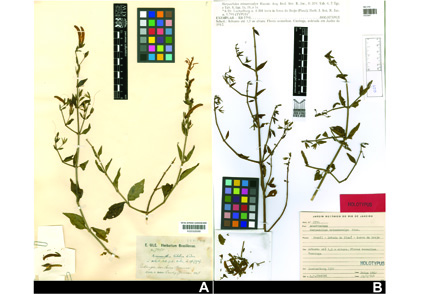Abstract
The genus Thyrsacanthus (Acanthaceae) was re-established to accommodate South American species of Anisacanthus recovered as phylogenetically distant from the main Anisacanthus lineage. However, some species of uncertain generic placement remained in Anisacanthus: Anisacanthus pohlii, known only from the type specimen destroyed during World War II; and A. trilobus, recently placed within the New World “justicioid” lineage. In this study, we show A. pohlii to be a later synonym for Thyrsacanthus ramosus and place A. trilobus in Justicia based on macromorphological, palynological, and molecular data. Additionally, lectotypes for the names Drejera ramosa and Anisacanthus pohlii were selected.
References
Chagas, E.C.O. & Costa-Lima, J.L. (2020b) Justicia. In: Flora do Brasil 2020. Jardim Botânico do Rio de Janeiro. Available from: http://reflora.jbrj.gov.br/reflora/floradobrasil/FB4137 (accessed 22 May 2021)
Côrtes, A.L.A., Borges, R.L.B. & Rapini, A. (2010) Reinstatement of Thyrsacanthus Moric. (Acanthaceae) and taxonomic novelties in the genus. Taxon 59 (3): 965–972. https://doi.org/10.1002/tax.593025
Côrtes, A.L.A., Rapini, A. & Daniel, T. (2015) The Tetramerium lineage (Acanthaceae: Justicieae) does not support the Pleistocene Arc hypothesis for South American seasonally dry forests. American Journal of Botany 102 (6): 992–1007. https://doi.org/10.3732/ajb.1400558
Daniel, T.F., McDade, L.A., Manktelow, M. & Kiel, C.A. (2008) The “Tetramerium Lineage” (Acanthaceae: Acanthoideae: Justicieae): delimitation and intra-lineage relationships based on cp and nrITS sequence data. Systematic Botany 33 (2): 416–436. https://doi.org/10.1600/036364408784571581
Hagen, S.H. (1941) A revision of the North American species of the genus Anisacanthus. Annals of the Missouri Botanical Garden 28 (4): 38–408. https://doi.org/10.2307/2394360
Lindau, G. (1897) Acanthace? American? et Asiatic?. Nov? vel minus cognit?. Bulletin de l’Herbier Boissier 5 (8): 643–681.
Lindau, G. (1914) Acanthaceae. In: Pilger, R (Ed.) Plantae Uleanae novae vel minus cognitae [Heft 3]. Notizblatt des Königlichen Botanischen Gartens und Museums zu Berlin 6 (56): 192–200. https://doi.org/10.2307/3994404
Linnaeus, C. (1753) Species Plantarum [...], vol. 1. Laurentii Salvii, Holmi? [Stockholm], pp. 1–560. https://doi.org/10.5962/bhl.title.669
Moricand, M.E. (1847) Plantes Nouvelles d’Amérique, livr. 9. Imprimerie de Jules-Gme Fick, Genève [Geneva], pp. 141–176, tab. 85–100. https://doi.org/10.5962/bhl.title.106626
Nees von Esenbeck, C.G.D. (1842) Observationes in Acanthaceas Horti Vratislaviensis. Linnaea 16 (3): 289–308.
Nees von Esenbeck, C.G.D. (1847a) Acanthaceae. In: von Martius, C.F.P. (Ed.) Flora Brasiliensis [...], vol. 9. Typographia Regia C. Wolf et fil. & Offic. Lithograph. S. Minsinger, Monachii [Munich] & Frid. Fleischer in Comm., Lipsi? [Leipzig], pp. 1–164, tab. 1–31. https://doi.org/10.5962/bhl.title.454
Nees von Esenbeck, C.G.D. (1847b) Acanthaceae. In: De Candolle, A. (Ed.) Prodromus systematis naturalis regni vegetabilis [...], vol. 11. Victoris Masson, Parisiis [Paris], pp. 46–519, 720–732 (Appendix). https://doi.org/10.5962/bhl.title.286
Rizzini, C.T. (1948) Disquisito circa Acanthacearum Aliquot genera Brasiliensia. Archivos do Jardim Botânico do Rio de Janeiro 8: 295–372.
Stafleu, F.A. & Cowan, R.S. (1976) Taxonomic literature: A selective guide to botanical publications and collections with dates, commentaries and types, ed. 2, vol. 1, A–G, Regnum Vegetabile 94. Bohn, Scheltema & Holkema, Utrecht, pp. 1–1136. https://doi.org/10.5962/bhl.title.48631
Stafleu, F.A. & Cowan, R.S. (1981) Taxonomic literature: A selective guide to botanical publications and collections with dates, commentaries and types, ed. 2, vol. 3, Lh–O, Regnum Vegetabile 105. Bohn, Scheltema & Holkema, Utrecht, pp. 1–980. https://doi.org/10.5962/bhl.title.48631
Turland, N.J., Wiersema, J.H., Barrie, F.R., Greuter, W., Hawksworth, D.L., Herendeen, P.S., Knapp, S., Kusber, W.-H., Li, D.-Z., Marhold, K., May, T.W., McNeill, J., Monro, A.M., Prado, J., Price, M.J. & Smith, G.F. (Eds.) (2018) International Code of Nomenclature for algae, fungi, and plants (Shenzhen Code) adopted by the Nineteenth International Botanical Congress Shenzhen, China, July 2017, Regnum Vegetabile vol. 159. Koeltz Botanical Books, Glashütten. https://doi.org/10.12705/Code.2018
Wasshausen, D.C. (1973) New combinations in cultivated Justicia (Acanthaceae). Baileya 19 (1): 1–3.


